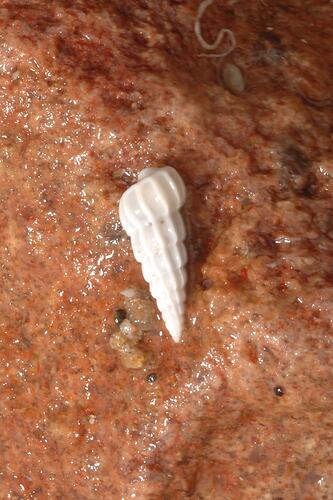General Description
Shell uniformly white-grey with regular thick ribs from the opening to the tip. Opening oval with a thickened lip. Shell up to 4 cm long.
Biology
Southern Wentletraps are carnivores, feeding on sea anemones. Like other Wentletraps, this species has a purplish saliva, which it may expel when disturbed. Wentletraps are protandric hermaphrodites, meaning they begin life as males then become females as they mature. Eggs are laid in spherical capsules encrusted by sand, which contain more than 100 eggs. Larvae hatch from the eggs as free-swimming larvae into the plankton where they may spend up to a month before settling and becoming adults. The name Wentletrap comes from the Dutch for spiral stairs.
Distribution
Southern mainland Australia and Tasmania.
Habitat
Under rocks at the low intertidal and shallow intertidal zones, associated with sea anemones.
More Information
-
Animal Type
-
Animal SubType
-
Brief Id
White shell, thick ribs.
-
Colours
White
-
Habitats
-
Diet
Carnivore
-
Diet Categories
Sea anemones
-
Endemicity
-
Commercial
No
-
Conservation Statuses
CITES: Not listed, FFG Threatened List: Not listed, DSE Advisory List: Not listed, IUCN Red List: Not listed
-
Depths
Shore (0-1 m)
-
Water Column Locations
On or near seafloor
-
Taxon Name
-
Scientific Author
(Lamarck, 1822)
-
Common Name
Southern Wentletrap
-
Other Names
Southern Wentle-trap
-
Phylum
-
Subphylum
-
Superclass
-
Class
-
Subclass
-
Superorder
-
Order
-
Suborder
-
Infraorder
-
Superfamily
-
Family
-
Genus
-
Subgenus
-
Species Name
australis




